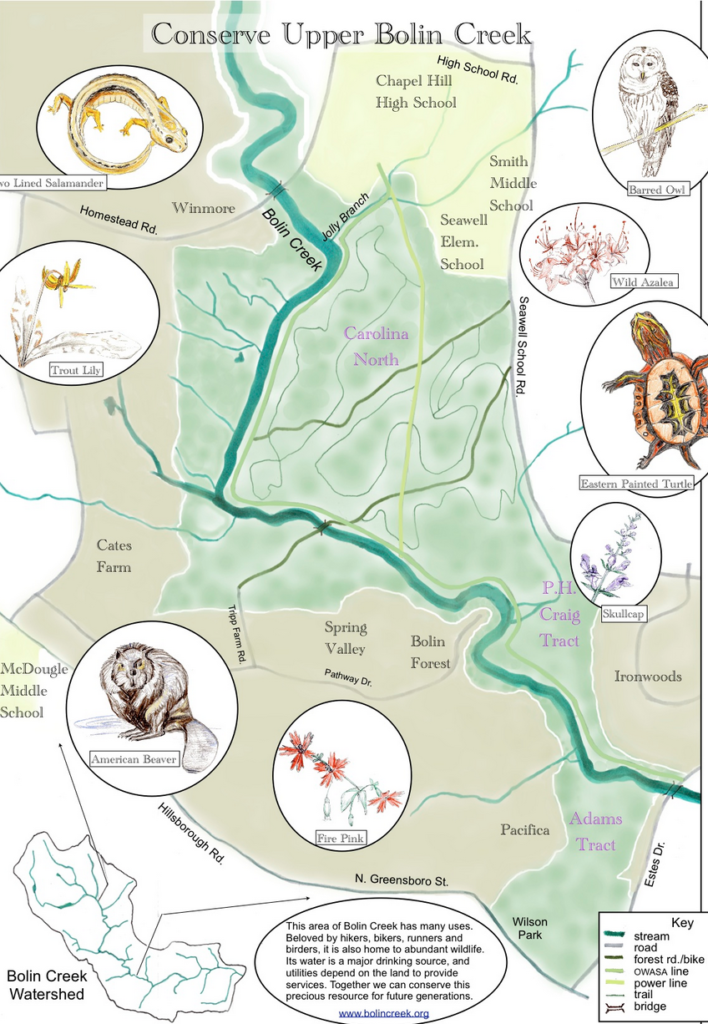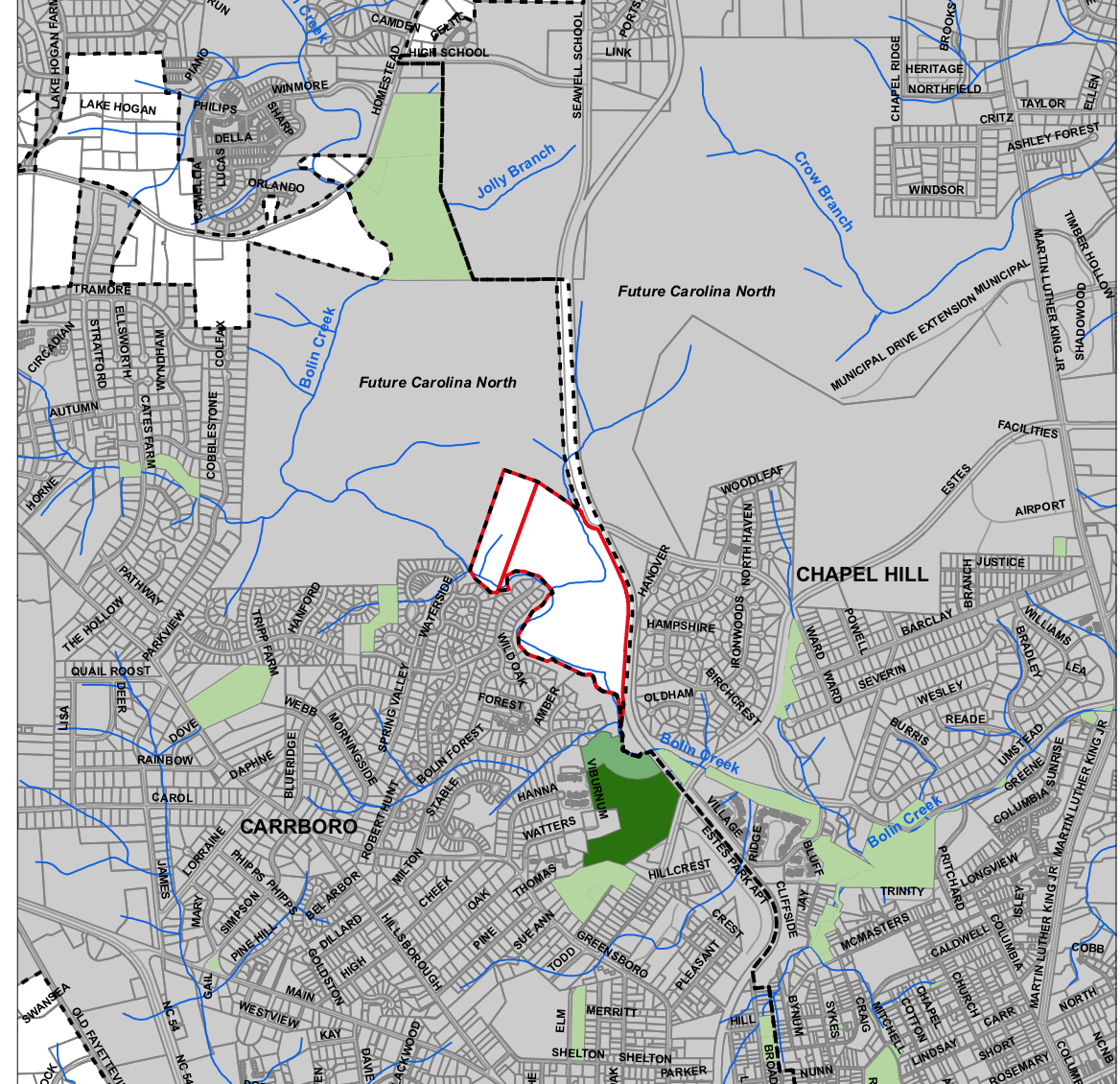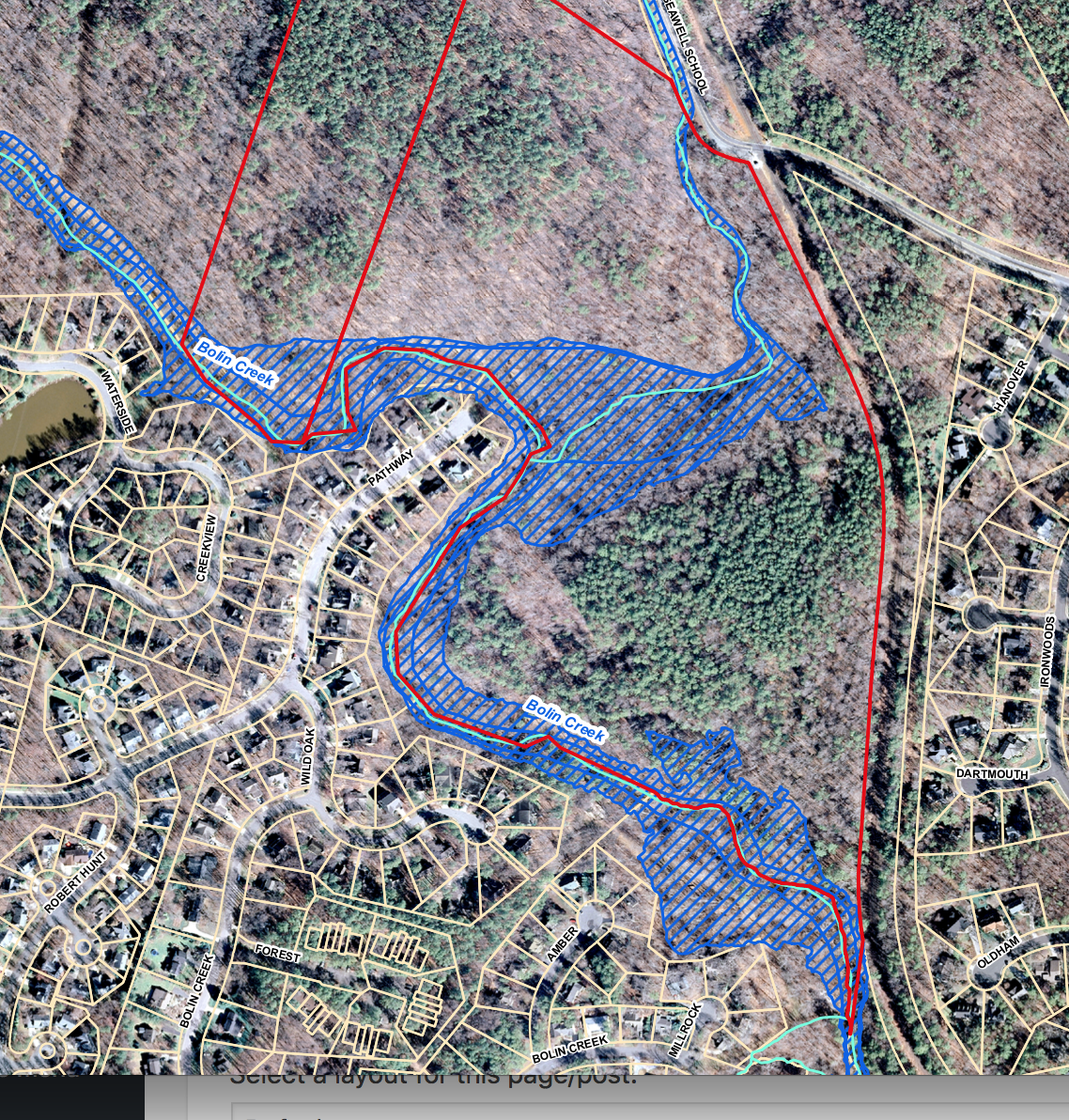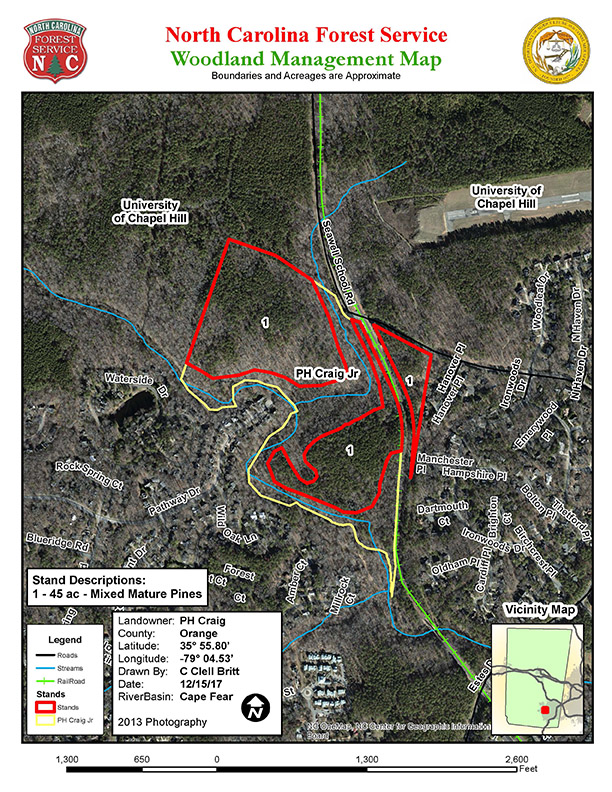News Flash: P.H. Craig is planning to log up to 40 acres of his property after protecting it for 50 years. Sign the petition here.
Report on 6/21 Community Meeting
Many thanks to Mayor Hemminger of Chapel Hill and Carrboro Mayor Lydia Lavelle, our wonderful panelists, Moderator Tom Cors, and meeting organizers Julie McClintock and Matt Durning. Here are some of the takeaways from the presentations and discussions:
Slides and maps used during the June 21st presentations are available here. (PDF)
Town Governments
Trish McGuire, Carrboro Planning Director, noted that the Craig property lies largely within Carrboro’s planning area but not within the town limits. She said the land is zoned as a (tree) farm and as such it is subject to reduced taxes and that Carrboro has very little oversight over the property. Mr. Craig has owned the property for 50 years without timbering but has every legal right to clear-cut the property as long as 50-foot stream buffers are preserved. She said Mr. Craig has indicated he plans to clear-cut 35 acres of the 77-acre parcel (areas indicated in red on the forest management map below). She also said he plans to access the property from Seawell School Road.
Lydia Lavelle, Carrboro Mayor, and Pam Hemminger, Chapel Hill Mayor, both said they would like to see the Craig property preserved but that the towns have no authority to stop the clear-cutting. Mayor Hemminger referenced a property on the corner of Estes Dr. and MLK as a place that individuals could currently see what clear-cutting looks like. Both Mayors said they had come primarily to listen and learn.
Panel: Bolin Forest Assessment
Doug Frederick, NCSU Forestry Professor, gave an assessment of current forestry practices and their relevance to Mr. Craig’s property. He noted that 80% of NC forests are in private ownership and many are held by owners like Mr Craig. Mr. Frederick described that the forest on this tract is a diverse mixture of mature upland hardwoods and pines that are in very good health and growing well. He expressed that in his assessment, there are few stands in the area, on private lands, that are as well-developed as the Craig stand and that it has significant ecological values, including water quality protection, wildlife habitat, plus long-term values for teaching and research.
This forest is a prime example of a forest entering “old-growth” conditions which makes it a special “reference forest” for management and ecological studies. In addition, its location in an urbanizing landscape makes it of exceptional value for recreation and as a mature forest greenspace. It also has high value for carbon sequestration due to the annual growth and large quantities of accumulated biomass. This forest has maximum ecological diversity unlike a young regenerating forest. The value of this tract ecologically far exceeds that of a pine plantation after clearcutting.
Mr. Frederick explained that while Mr. Craig’s forestry plan – clear-cutting and replanting with loblolly pine trees — is consistent with good forestry practices on typical tree farms, the unique conditions of Mr. Craig’s property make it worthy of conservation. He cited 80 years of undisturbed growth, proximity to Bolin Creek, and its “keystone” position next to the 325-acre UNC tract to the north and the 27-acre Carrboro and Orange County ‘Adams’ tract purchased in 2003. In summary, Mr. Frederick believes that Mr Craig’s forest is far more valuable, both now and into the future, as a protected “old growth” forest for wildlife habitat and recreational space rather than as a timber farm. He further noted that this tract has been identified as a North Carolina Natural Heritage Site which means it has special ecological significance recognized by the State.
In response to Mr. Craig’s stated concerns over pine beetle infestation as a rationale for why he needs to timber at the present time, Mr. Frederick stated that in his personal assessment of the property he saw no evidence to validate this concern. Instead, he noted that many of the mature trees could easily live for another 50-80 years and that natural tree life cycles could be allowed to play out without undue risk of fire or beetle infestation.
Mr. Frederick reported on a phone conversation with Mr. Craig’s private consulting forester, Mr. Bill Dryman. Based on Mr. Dryman’s shared numbers and his own assessments, he ventured that the timber would bring $100,000 to $200,000 to Mr. Craig before harvesting expenses.
In conclusion, Frederick said this was a special piece of property that should not be treated as a typical tree farm, and he saw no reason that it needed to be clear cut now or at any time in the near future.
Michael Paul, Environmental Researcher and Steam Ecologist, said Bolin Creek was currently a “threatened” creek as defined by the EPA. Upstream development has had a major impact on the quality of Bolin Creek. He said that because of the topography, it would be very difficult to clear-cut this property without further compromise to erosion. He explained that a separate set of rules apply to silviculture and Mr. Craig does not need to seek any environmental permit unless and until he is found to be out-of-compliance. He observed that timbering can radically change the hydrology of a site – trees take in a lot of water and without them there would likely be more runoff and siltation into the creek. He also noted that trees reduce water temperatures, thus improving plant life. He cited heightened risks of more sediment into Bolin Creek and increased water temperatures as the major threats following a clear-cutting of this property.
Mary Sonis, naturalist and photgrapher, reviewed many of the birds and animals that call this property home or who use this long contiguous forest as a stop over resting area during migration. Mr. Craig’s property provides habitats for migrating warblers as well as mink, coyotes, beaver, and deer. Many of the birds and a four-toed salamander are threatened but not on the Endangered Species List.
Bo Howes, Triangle Land Conservancy, reviewed the Triangle Land Conservancy’s (TLC) history with this piece of land. He said the TLC had been interested in preserving and purchasing this piece of property for many years. It qualifies for funding because of the many scientific studies demonstrating its high ecological value. He said that up to now, Mr. Craig had never been willing to sell any of his many properties in our area. He said it was difficult to raise money for a piece of property quickly and that it would make sense to find a way to identify an intermediate step to stop the clearcut so funds could be raised to purchase the land outright. However, he noted if an owner does not want to sell, it’s impossible to set a fair price. He also said that buying a conservation easement was unlikely in this type of situation.
Public comment
One audience member wondered if eminent-domain seizure would be possible but all panelists agreed that would not be a reasonable or feasible course of action.
Local resident Steve Campbell, who said Mr. Craig had asked him to attend, noted Mr. Craig’s love for this piece of land and reminded the audience that Mr. Craig had allowed it to be used and enjoyed by everyone for 50 years. He expressed that any plan that would challenge Mr. Craig’s rights would be counterproductive. However, he thought that sincere efforts to rightfully honor Mr. Craig’s conservation legacy — both by residents and by both towns and the county — might speak to him.
Many audience members expressed a desire to thank Mr. Craig for sharing his property with the public for so many years and a willingness to contribute monetarily towards a campaign to pay Mr. Craig for the value of the timber harvest (to prevent the clearcutting) and to help the towns purchase the land from Mr. Craig at fair market value.
Materials
Slides and maps used during the June 21st presentations are available here. (PDF)
Audio excerpts of the meeting will soon be available here.
“Why I have to Clear Cut Part of the PH Craig Tract” , PH Craig, Herald Sun
Come to the Meeting!
One of the favorite places to hike in the area is the 77 acre tract owned by PH Craig next to Carolina North. Join your neighbors and friends and attend the community meeting to answer questions about the impending clearcut of this amazing forest. Learn more about best forestry practices that could apply to Bolin Forest.
Show the Mayors of Carrboro and Chapel Hill that you care what happens!
PH Craig Property and the Future of Bolin Forest
7:00 – 9:00 pm Thursday, June 21st, Smith Middle School
To sign a letter to protect this beautiful forest, Sign here
Several years ago the Governor awarded the Long Leaf Pine award to Mr. Craig for protecting this land. According to the announcement, “it contains one half mile of beautiful Bolin Creek and North Carolina foresters say its foot traffic is greater than that of Umstead State Park.”
But PH Craig has announced his intention to clearcut at least 35 acres of trees on his property. (See area map below.) The “woodland management plan” targets pines, but trees in the upland portions will be removed down to a line of trees marked with pink ribbons just 150 feet from Bolin Creek.
PH Craig’s land is sandwiched between two other lands that are largely protected from development, the 325-acre University-owned Carolina Forest and the 27 acre Adams Preserve. The PH Craig land contains beautiful and significant stands of beech trees.
If you cannot attend Thursday’s meeting in person, please make sure to sign our petition before Thursday and share the meeting details and event poster via your social media channels.






